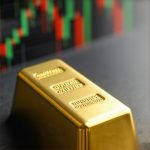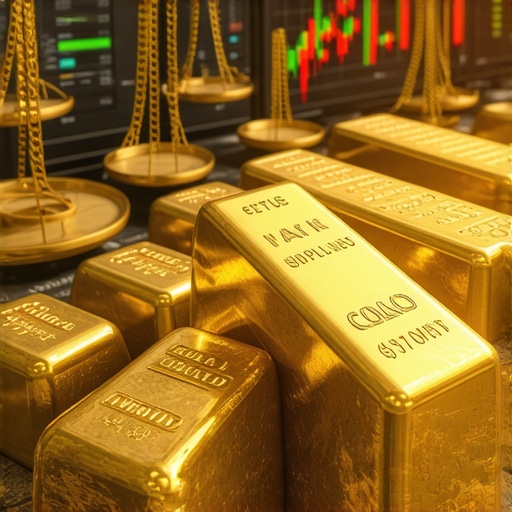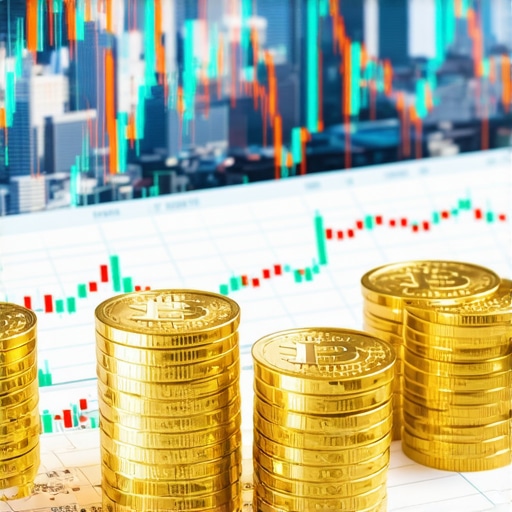Understanding the Nexus Between Global Economics and Gold Price Trajectories in 2025
As seasoned analysts in the financial sector, we recognize that the dynamics of global economics profoundly influence gold prices, particularly in the context of 2025. The intricate interplay of geopolitical stability, monetary policies, and macroeconomic indicators creates a complex environment where gold serves as both a safe-haven asset and a reflection of global economic health. This article delves into these factors with a nuanced perspective, providing insights rooted in experience and rigorous analysis.
Key Economic Indicators That Will Drive Gold Price Fluctuations
Central to understanding future price movements are indicators such as inflation rates, currency stability, and interest rate trends. For instance, persistent inflationary pressures in major economies may compel investors to seek gold as a hedge, thereby elevating prices. Conversely, tightening monetary policies, like rate hikes by the Federal Reserve or European Central Bank, could temporarily suppress gold demand due to higher opportunity costs. Analyzing these metrics using advanced market analysis tools enables more accurate forecasts for 2025.
The Impact of Geopolitical Tensions on Gold’s Safe-Haven Status
Geopolitical uncertainties, including conflicts, trade disputes, or regional instability, tend to amplify gold’s role as a refuge. In 2025, ongoing tensions in areas such as the South China Sea or Eastern Europe could trigger short-term surges in demand. Historically, such episodes have demonstrated that gold often moves inversely to risk appetite, reinforcing its position as a strategic asset during turbulent times. For investors, understanding these patterns is crucial for building resilient portfolios, especially considering gold’s hedge properties against inflation and stock market risks.
How Will Central Bank Policies Shape Gold Prices in 2025?
Central banks remain pivotal players by their gold purchasing and reserve management strategies. An aggressive accumulation of gold reserves by nations like China and India signals a strategic shift that could underpin price appreciation. Conversely, if major economies pivot towards reducing gold holdings, it may exert downward pressure. The influence of such policies is analyzed in depth via recent research on central bank activities. Understanding these patterns ensures investors stay ahead of policy-driven movements in the gold market.
What are the implications of technological innovations and green energy trends on gold demand?
Emerging technologies, including advancements in electronics and renewable energy infrastructure, are poised to impact gold demand significantly. Gold’s unique properties make it essential in high-precision electronics and sustainable technologies, potentially expanding its market base beyond traditional investors. Monitoring these trends through comprehensive market analysis reports will be vital for strategic positioning in 2025.
To deepen your understanding of how to navigate the evolving gold landscape, explore our expert strategies for safe physical gold investments in 2025. Share your insights or ask questions to foster a community of informed investors shaping the future of gold in a rapidly changing global economy.
How Will Emerging Technologies and Green Energy Drive Gold Demand in 2025?
As we look ahead to 2025, technological innovations and the shift towards renewable energy sources are poised to reshape gold’s role in the global economy. Gold’s unique conductive and corrosion-resistant properties make it indispensable in high-tech electronics, including smartphones, satellites, and quantum computing components. Additionally, the burgeoning green energy sector, particularly in solar and wind technologies, relies heavily on gold for its electrical connections and durability.
Investors need to recognize these emerging demand drivers. According to a comprehensive report by the Gold Market Analysis 2025, the expansion of electronics and renewable energy markets could lead to sustained or even increased gold prices, independent of traditional financial variables. This shift underscores a strategic opportunity for those who understand and anticipate technological adoption trends.
Can Market Sentiment and Investor Behavior Outpace Fundamental Factors?
While macroeconomic indicators and geopolitical tensions provide a foundation for gold price forecasts, investor sentiment often acts as a catalyst, amplifying or dampening market movements. Behavioral finance suggests that perceptions, fears, and speculative actions can cause short-term volatility that diverges from fundamental valuations.
In 2025, understanding these psychological factors becomes critical. For instance, during periods of economic uncertainty or post-pandemic recovery, gold can experience rapid price surges driven by fear and flight-to-safety behaviors. Conversely, bullish market sentiment in equities or cryptocurrencies might temporarily suppress gold demand, despite underlying fundamentals. To navigate this complex landscape, investors benefit from advanced market analysis tools that incorporate sentiment analysis and trend forecasting.
What innovative strategies can help investors leverage volatility for profit?
Expert investors are increasingly turning to dynamic trading techniques such as options, futures, and technical analysis to capitalize on gold’s inherent volatility. Using tools like gold futures and technical analysis, they can time entries and exits more precisely, optimizing returns while managing risk. Moreover, diversifying across various gold assets—coins, bars, ETFs, and mining stocks—can further enhance portfolio resilience.
For a deeper dive into these strategies, explore our best strategies for safe physical gold investments in 2025. Share your experiences or ask questions in the comments section—building a community of informed investors is the key to thriving in the ever-evolving gold market.
Emerging Technological Paradigms and Their Disruptive Effects on Gold Demand
As we venture further into the decade, the integration of cutting-edge technologies like quantum computing, 5G, and sophisticated electronics heralds a new era for gold’s industrial applications. Gold’s unparalleled conductivity, malleability, and resistance to corrosion make it indispensable in the burgeoning fields of quantum devices and high-frequency telecommunications. For instance, the global push towards quantum internet infrastructure could elevate gold’s role in ensuring the integrity of secure data transmission, thus creating sustained demand.
Furthermore, innovations in sustainable manufacturing practices and the growth of green energy sectors are amplifying the significance of gold in renewable energy technologies. Solar panels, wind turbines, and energy storage systems increasingly rely on gold for their electrical contacts and connectors, underscoring its strategic importance beyond traditional investment. According to a recent study by the IEEE Transactions on Industrial Electronics, the demand for gold in renewable energy infrastructure could surge by over 20% by 2030, significantly impacting supply-demand dynamics in the coming years.
Deciphering the Nuances of Investor Sentiment and Market Psychology in Gold Price Volatility
While macroeconomic fundamentals set the stage, investor psychology often acts as a catalyst that amplifies or tempers price movements. Advanced sentiment analysis tools utilizing natural language processing (NLP) models now enable investors to gauge market moods by analyzing news, social media, and institutional reports in real-time. This approach allows for a more nuanced understanding of potential short-term price swings driven by collective psychology.
For example, during periods of geopolitical crises, fear and uncertainty tend to spike, prompting a flight to gold. Conversely, bullish sentiment in equities or digital assets can lead to a temporary decline in gold prices, despite underlying macroeconomic pressures. Recognizing these psychological patterns allows investors to develop contrarian strategies or hedge positions that capitalize on market overreactions, an approach detailed extensively in the CFA Institute’s research on behavioral finance.
Advanced Investment Techniques: Exploiting Gold’s Volatility for Strategic Gains
In today’s complex markets, sophisticated investors leverage derivatives such as options and futures to navigate gold’s inherent volatility. These instruments provide flexibility in timing and risk management, enabling traders to implement strategies like straddles, strangles, or calendar spreads. For example, a well-timed options contract can profit from anticipated geopolitical shocks or macroeconomic data releases.
Moreover, algorithmic trading systems integrated with machine learning algorithms can identify short-term price anomalies, providing a quantitative edge. Diversification remains critical; combining physical assets like bullion and coins with paper assets such as ETFs or mining stocks can buffer against sudden market shocks. To deepen your mastery of these strategies, explore our detailed guide on using futures and technical analysis for gold trading.
How can investors incorporate AI-driven sentiment analysis into their gold investment strategies?
By harnessing artificial intelligence, investors can process vast datasets—ranging from news headlines to social media chatter—to derive actionable insights about market sentiment. Sophisticated AI models can detect emerging trends or shifts in investor confidence weeks or even months before they materialize in price movements. This proactive approach enables more strategic entry and exit points, mitigating risk and maximizing returns. Institutions are already deploying such systems; retail investors can access simplified versions through specialized platforms, making AI-driven sentiment analysis an indispensable tool in the modern investor’s arsenal.
If you’re eager to refine your approach and stay ahead of market trends, consider integrating these advanced analytical tools into your strategy. For ongoing insights and expert advice, subscribe to our newsletter or join our dedicated investor community for real-time updates and discussions.
Deciphering the Role of Quantum Technologies and Gold’s Industrial Revolution in 2025
As technological frontiers expand, quantum computing and next-generation communication networks are poised to redefine gold’s industrial applications. Gold’s exceptional conductivity and stability make it indispensable in quantum hardware and secure data transmission. The integration of quantum internet infrastructure could significantly elevate gold demand, fostering a new paradigm in industrial utilization that complements its traditional financial role.
According to the IEEE Transactions on Industrial Electronics, demand for gold in high-tech sectors may increase by over 20% by 2030, profoundly impacting supply-demand dynamics and pricing structures. Investors who recognize this shift early can strategically position themselves to capitalize on the industrial renaissance driven by innovation.

Analyzing the Impact of Geopolitical Shifts and Economic Realignments on Gold’s Safe-Haven Appeal
Geopolitical realignments, including emerging alliances and regional conflicts, continue to influence gold’s status as a global safe haven. The evolving landscape of international power dynamics, especially in regions like the Indo-Pacific and Eastern Europe, introduces volatility that can trigger rapid surges in gold demand. Cross-border investments and strategic reserves are increasingly shaped by these geopolitical considerations, demanding sophisticated analysis of global risk factors.
Expertise in geopolitical risk assessment, supplemented by real-time intelligence and scenario modeling, enables investors to anticipate market movements. The World Economic Forum’s reports on geopolitical risk provide nuanced insights into potential flashpoints, helping investors craft resilient strategies amid uncertainty.
How Can Artificial Intelligence and Big Data Revolutionize Gold Market Predictions?
Harnessing AI and Big Data analytics allows for unprecedented precision in predicting gold price movements. Natural Language Processing (NLP) models analyze vast streams of news, social media, and institutional reports, capturing market sentiment and emerging trends before they influence prices. Machine learning algorithms can identify subtle patterns and generate forward-looking forecasts, giving investors a strategic edge in volatile markets.
Institutions are increasingly deploying AI-driven sentiment analysis platforms, which synthesize data to produce actionable insights. Retail investors aiming for competitive advantage should explore tools integrated with predictive analytics and sentiment metrics, as outlined in recent industry case studies by the CFA Institute.
What are the Most Sophisticated Investment Techniques to Exploit Gold’s Volatility in 2025?
Advanced investors leverage derivatives such as options spreads, futures contracts, and algorithmic trading systems to navigate gold’s inherent volatility. Employing strategies like calendar spreads or straddles enables profit from short-term price swings driven by macroeconomic data releases or geopolitical shocks. Automated trading algorithms, powered by machine learning, can execute trades with precision, capitalizing on fleeting opportunities while managing risk effectively.
Enhancing diversification through a combination of physical assets, ETFs, and mining equities further mitigates portfolio risk. Deepening mastery of these techniques requires continuous education, with resources like specialized trading platforms and expert-led webinars providing essential insights for 2025.
Integrating Sustainability and Green Technologies into Gold’s Future Market Dynamics
With the global emphasis on sustainability, the green energy sector’s reliance on gold is intensifying. Solar panel manufacturing, wind turbines, and energy storage systems increasingly depend on gold for electrical contacts and corrosion resistance. This trend not only sustains demand but also introduces new supply chain considerations, including ethical sourcing and environmental impact assessments.
According to a comprehensive analysis from the International Energy Agency, the integration of gold into renewable energy infrastructure could escalate by over 20% by 2030, significantly influencing market dynamics. Investors should monitor developments in green energy policies and technological adoption to identify emerging opportunities and risks in gold investments.
Expert Insights & Advanced Considerations
1. Gold’s Industrial Expansion Will Accelerate
As technology advances, gold’s role in electronics, quantum computing, and green energy will become even more critical, supporting sustained demand and price stability in 2025.
2. Geopolitical Risks Continue to Drive Safe-Haven Demand
Regional conflicts and shifting alliances will keep gold as a preferred hedge, necessitating vigilant geopolitical risk analysis for strategic positioning.
3. Central Bank Policies Are Diverging Significantly
Some nations will increase gold reserves amidst monetary tightening, while others may reduce holdings, creating complex price dynamics that require sophisticated monitoring and analysis.
4. Technological Innovations Will Transform Market Analysis
AI-driven sentiment analysis and Big Data will revolutionize market forecasting, enabling investors to anticipate price movements with unprecedented precision.
5. Sustainability Trends Will Shape Future Demand
Growth in renewable energy infrastructure will sustain and potentially increase gold demand, emphasizing the importance of ethical sourcing and environmental considerations in investment strategies.
Curated Expert Resources
- Gold Market Analysis 2025: Provides comprehensive insights into emerging market drivers, supply-demand dynamics, and price forecasts, essential for strategic planning.
- IEEE Transactions on Industrial Electronics: Offers technical research on gold’s role in quantum computing and electronics, highlighting industrial demand shifts.
- World Economic Forum Reports: Delivers nuanced geopolitical risk assessments crucial for understanding macroeconomic influences on gold prices.
- CFA Institute Behavioral Finance Research: Explores investor psychology and sentiment analysis techniques, vital for navigating short-term volatility.
- International Energy Agency Reports: Details the expansion of green energy infrastructure and its impact on gold demand, guiding sustainable investment approaches.
Final Expert Perspective
The landscape of gold investment in 2025 will be shaped by an intricate blend of technological innovation, geopolitical shifts, and macroeconomic policies. Recognizing the evolving industrial applications of gold alongside the traditional safe-haven appeal will enable informed, strategic decisions. Staying ahead requires leveraging advanced analytical tools, embracing sustainability, and understanding global risk factors. Engage with our resources, share your insights, and contribute to a community of expert investors committed to mastering the complexities of the gold market—your future wealth depends on it.










